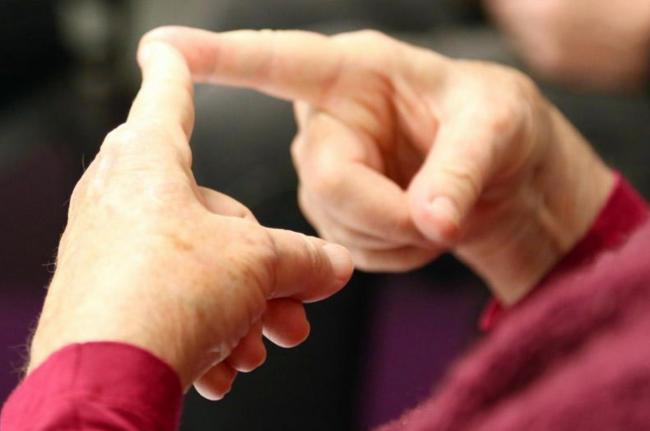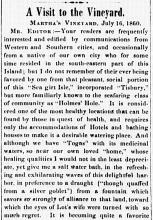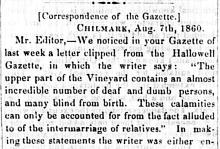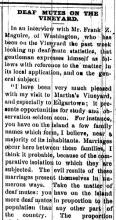This weekend, the Island remembered a time when many of its residents were bilingual -- when Vineyarders spoke both English and sign language and for over 250 years the deaf were accepted, not stigmatized by society.
It is a remarkable part of Island history, yet it seldom is the cause for celebration as it is a history that has been largely forgotten in recent years.
Until last Friday. On Friday, Vineyard residents and visitors were reintroduced to the Island’s signing history at the very first Sign Language Heritage Event, held at the Old Whaling Church in Edgartown.
About fifty people turned out for the event which featured deaf actor Anthony Natale as its guest speaker. A Toronto native, Mr. Natale played the adult deaf son of Richard Dreyfuss in Mr. Holland’s Opus; he has also appeared in Jerry Maguire, the television sitcom Ellen and a number of television commercials.
Mr. Natale spoke about the frustration of not being able to communicate his thoughts to people as a young child and the ultimate satisfaction of being able to express them when he mastered sign language. He spoke about the challenges he faced pursuing his dreams to be an actor, when those around him thought that his inability to hear would prevent him from being successful.
“I was stubborn, said Mr. Natale. “I was not going to let go of my dream.”
Mr. Natale said that holding onto his dreams, being able to fulfill goals and having patience are the three things that have been most important to his success. He urged all of the audience members to hold onto their dreams.
Friday’s audience glimpsed an environment where being deaf was considered normal when Jill Nichols, a high school student who is deaf, signed stories from Harvard anthropologist Nora Ellen Groce’s book, Everyone Here Spoke Sign Language. Published in 1985, Mrs. Groce’s book traces the Island’s hereditary deafness back to a group of early Vineyard settlers who came to the Island from The Weald/Kent, England, in 1642.
The telephone inventor, Alexander Graham Bell, made the first attempt to find out the source of Island deafness, but was not successful.
Building on Mr. Graham Bell’s genealogical research, town records and the memories of aging citizens, Mrs. Groce discovered that the recessive gene for deafness was brought to the Vineyard by an early settler from England and then passed down for 12 generations. Due to a high rate of intermarriage among town residents, by the 1800s the incidence of hereditary deafness on the Island was extraordinarily high: At that time, one in every 155 Islanders was born deaf -- more than 300 times the national average. Incidence of hereditary deafness was greatest in Chilmark and West Tisbury.
However, because of the high incidence of Vineyard deafness and the isolation that comes with living on an Island, being deaf was not something to be ashamed of and hearing residents adapted to the unique circumstances by learning the combination of English and native signs that Island deaf used to communicate.
It was this spirit of acceptance that Vineyarders celebrated on Friday night. The selections that Jill Nichols signed from Nora Groce’s book depicted a time when people did not differentiate between hearing and non-hearing neighbors and sign language was used because it was practical.
Other guest performers Friday evening include the Vineyard high school Minnesingers, who signed and sang a cappella the song Love in Any Language, as the group did for the Royal West of London School for the Deaf in Exeter last year. Martha’s Vineyard native Betsy Bogges shared her personal experiences as the mother of a deaf child and composer, and folklorist Dillon Bustin performed Lead, Kindly Light, a song inspired by a true story of a deaf/hearing couple and part of Mr. Bustin’s musical about the Vineyard, Tidebook: An Island Rhapsody.
The Sign Language Heritage Event was followed by a free, open-captioned screening of Mr. Holland’s Opus at Edgartown Cinema.
Los Angeles producer and writer Christine Jenkins, the sponsor of the Sign Language Heritage Event, said she hopes to make the celebration an annual tradition on the Vineyard. Miss Jenkins discovered the Vineyard’s signing history while doing research for her award-winning video, How to Talk to a Person Who Can’t Hear, which teaches sign language in a fun and entertaining way. She decided to sponsor a program celebrating the Island’s bilingual history when she visited the Vineyard as part of her tour promoting the video.
“When I realized the younger residents, and really America at large, was not aware that a place had existed where the hearing and deaf were in complete harmony and communication, I decided to find a way to share this fascinating fact,” said Miss Jenkins.
At the turn of the century, an influx of new population opened up the Island’s isolated gene pool, eliminating the gene for hereditary deafness. The last resident with hereditary deafness died in 1952 and increasingly, the residents who remember a time when the Island was bilingual are few.
But Miss Jenkins believes the spirit that developed among Islanders in the days when the Vineyard was bilingual lives on. She said that since deaf communities have a wonderful natural support system, many people believe the spirit of acceptance that prevailed among Vineyarders when signing was a part of daily life has greatly contributed to the feeling of community that Martha’s Vineyard enjoys today.










Comments